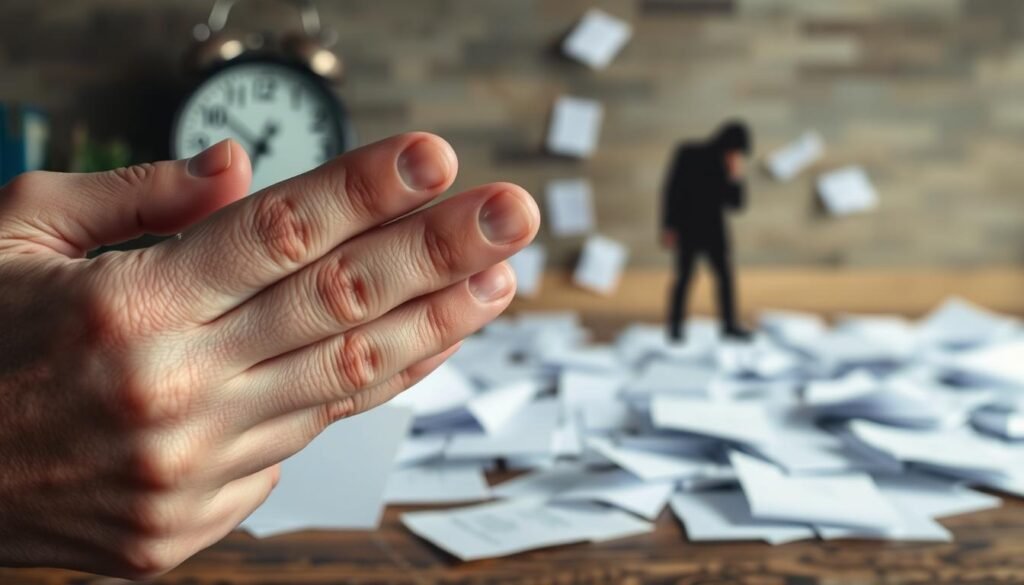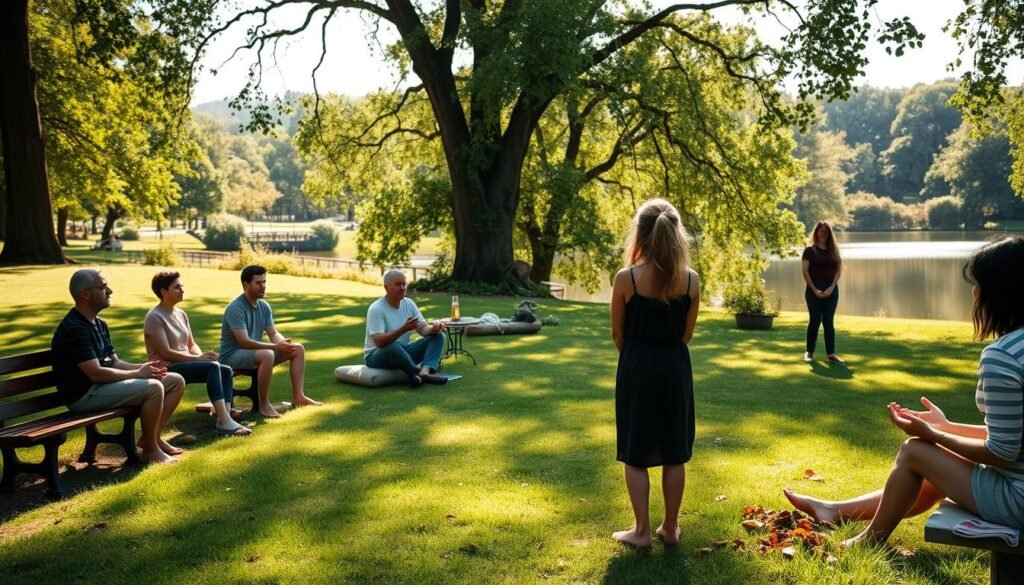Did you know that each year, over 19% of U.S. adults face anxiety disorders? This fact shows why it’s crucial to learn fast anxiety relief methods. Many people deal with sudden stress and fear at different times. Finding quick ways to ease anxiety is key for handling daily challenges and improving wellbeing. In this article, you’ll learn effective strategies to lessen anxiety quickly. From breathing exercises to grounding techniques, these methods will help you find peace of mind.
Key Takeaways
- Seeking fast relief for anxiety is crucial for maintaining well-being.
- Breathing exercises can trigger the parasympathetic nervous system for calming effects.
- Grounding techniques help engage the senses to promote relaxation.
- Physical activity boosts endorphins and reduces feelings of anxiety.
- Certain distractions, like music, can provide relief from overwhelming emotions.
- Engaging the prefrontal cortex by describing emotions fosters better emotional management.
- Visualization techniques can effectively reduce anxiety symptoms, promoting a sense of safety.
Understanding Anxiety and Its Impact
Anxiety is a natural way we respond to threats and stress. It’s something we all face at times in our lives. The effect of anxiety impact is not just on our feelings. It can also affect our thinking, our health, and how we get along with others. People dealing with anxiety might not sleep well, feel tired often, and get easily upset. This makes everyday tasks more difficult.
Anxiety shows up in both how we feel and our body’s reactions. Knowing these signs can help us understand anxiety better. You might notice your heart beats faster, you sweat more, or feel scared. These feelings can lead to panic attacks, which are intense waves of fear. It’s crucial to know how to handle these attacks.
Many things can cause anxiety to start and stick around. Our mental habits, social life, and even childhood can play a part. Having family members who have been anxious adds to the risk. Thoughts that automatically pop into our head, like expecting the worst, make anxiety worse.
Experts say accepting your anxious thoughts can actually make them less powerful. Talking about your worries with someone you trust can help too. This advice gives people a way to deal with stress. Focusing on actions that help, like exercising or paying attention to the present moment, can make you feel better. These activities help people handle their anxiety better and improve their overall happiness.
| Factors Contributing to Anxiety | Potential Solutions |
|---|---|
| Negative self-beliefs | Mindful meditation |
| Social experiences | Social connectedness |
| Biological predispositions | Cognitive behavioral therapy |
| Panic attacks | Physical activity |
| Unhelpful thinking patterns | Emotional journaling |
Recognizing the Signs of Anxiety
It’s crucial to know the signs of anxiety to manage it well. Knowing these signs lets people take control of their emotions early. Some common symptoms are:
- Rapid heartbeat
- Increased sweating
- Difficulties in concentrating
- Irritability
- Restlessness
Everyone feels these signs in their way, so knowing oneself is key. Writing in a journal helps to spot when and why anxiety spikes. Spotting these patterns early is part of managing anxiety.
When anxiety never seems to leave or messes with daily life, it’s time to get help. Therapy often works well, sometimes even from the first visit. Cognitive-behavioral therapy, which often needs eight to ten visits, can have lasting benefits. Be sure to check if your health insurance covers mental health to lessen money worries.

Trying things like guided meditation or deep breathing can offer quick relief from anxiety. Adding physical activities like dancing or cleaning can help shift anxious feelings into something more peaceful. Scheduling worry time and facing feelings without harsh judgment can teach people to handle anxiety better.
| Signs of Anxiety | Strategies to Ease Symptoms |
|---|---|
| Rapid heartbeat | Deep breathing exercises |
| Difficulty concentrating | Mindfulness techniques |
| Restlessness | Physical activities |
| Irritability | Guided imagery |
| Sweating | Changing positions |
Dealing with anxiety can seem hard, but with the right knowledge and tools, it’s possible to manage it better and find fast relief.
How to Lower Anxiety Fast: Effective Strategies
Looking for ways to calm anxiety naturally is key to keeping your mind healthy. There are effective methods that offer quick relief. Among them, diaphragmatic breathing and simple stretches are very helpful.
Diaphragmatic Breathing for Instant Calm
Diaphragmatic breathing is a top fast anxiety coping technique. It helps activate the calm response of the body. Here’s how to do it:
- Get comfy, sitting or lying back.
- Put one hand on your chest, the other on your belly.
- Breathe in deep through your nose, belly should go up, chest stays still.
- Breathe out slow through your mouth, belly goes down.
- Keep this up for a few minutes, just focus on your breathing.
This breathing can quickly lower anxiety and bring peace to your whole body.
Simple Stretches to Release Tension
Moving your body is also great for easing anxiety. Doing some easy stretches helps loosen muscle tension. Try rolling your head, shrugging your shoulders, or stretching your neck gently. Doing these regularly helps your mind feel better.
For other quick anxiety reduction techniques, check out this resource. There, you’ll find more great tips for feeling well.

| Technique | Description | Benefits |
|---|---|---|
| Diaphragmatic Breathing | It’s a deep breathing exercise that focuses on the belly rising. | Lowers stress, brings calm. |
| Simple Stretches | Easy movements targeting tight spots in the body. | Eases muscle tightness, boosts mood. |
Grounding Techniques: Staying Present
Grounding techniques help us stay in the moment during times of anxiety. They shift our focus away from distressing emotions to what’s around us. This makes it easier to calm down and feel in control again.
The 5-4-3-2-1 Grounding Technique
The “5-4-3-2-1” method works really well. It uses our senses to help us recognize feelings. You go through steps like:
- Identifying 5 things you can see
- Recognizing 4 things you can touch
- Listening for 3 things you can hear
- Smelling 2 things you can smell
- Tasting 1 thing you can taste
This technique makes us more aware of the present. It also stabilizes our feelings by focusing on what we can sense around us.
Using Your Words to Acknowledge Feelings
Putting our feelings into words is key in handling anxiety. By asking ourselves about our feelings, we can stay grounded. This mental effort helps us understand and control our emotions better. Talking about emotions can clear up confusion and lower anxiety.
Adding grounding techniques to our daily life can improve our wellbeing. These methods are good tools for dealing with anxiety.

Engaging in Physical Activity
Moving your body every day can cut down on feelings of anxiety. Moving helps your mental health and stops bad habits. Physical activity is a natural, strong way to feel better overall.
Benefits of Exercise for Anxiety Relief
Studies show that working out can calm anxiety as well as meds for some people. Moving makes endorphins, which make you feel good. Low or high-intensity exercises can quickly lower anxiety.
Adults should work out moderately for at least 2½ hours a week, say federal guidelines. It’s key to keep up with exercises like:
- Walking
- Jogging
- Dancing
- Bicycling
- Yoga
- Swimming
Even quick workouts are good. For instance, three 10-minute walks work as well as one 30-minute walk. Setting SMART goals helps you track your exercise wins and stay motivated.
| Type of Activity | Intensity Level | Guideline for Adults |
|---|---|---|
| Moderate Aerobic Activity | Moderate | At least 150 minutes per week |
| Vigorous Aerobic Activity | High | At least 75 minutes per week |
| Strength Training | N/A | At least 2 times per week |
Being active eases anxiety and depression signs and boosts confidence and mood. It encourages better sleep, often disturbed by stress. With exercise, you find healthy ways to deal with issues, avoiding bad habits.
Visualizing Peacefulness and Safety
Visualization is a powerful way to visualize safety and feel calm. By imagining peaceful places or happy memories, people can feel safe and relaxed. This can help shift focus from worry and bring positive physical changes.
With regular practice, people become more mindful of stress. Linking calming images with comfort makes it easier to feel calm when needed. Guided imagery is especially helpful in reducing stress quickly.
Seeing certain colors in your mind can be protective. For example, picturing white light can shield against negative vibes.
- Visual exercises can make sleep better.
- Thinking of calm scenes can lower your heart rate.
- Using all your senses in these practices increases relaxation.
Trying different visualization methods is important. If one doesn’t work, another might. For those stressed often, regular visualization practice can prevent burnout.
| Benefits of Visualization Techniques | Effects |
|---|---|
| Improved Sleep Quality | Leads to better overall health |
| Reduced Heart Rate | Encourages relaxation and calmness |
| Enhanced Emotional Well-being | Shields against negative thoughts |
Practicing visualization allows people to use their imagination to fight daily stress. It helps build peace and resilience.
Distraction Methods: Redirecting Your Mind
Distraction techniques for anxiety help manage hard feelings. By focusing away from stressful thoughts, a person can find peace. Music is key in this effort.
Soft tunes add calmness and create peace. This helps when feeling anxious.
Using Music as a Calming Tool
Listening to music can make tension melt away. Calming music is a nice escape, letting people enjoy the peaceful sounds. Studies prove music helps with relaxation.
It’s a top method for quick relief from anxiety.
Creating a New Playlist for Mood Enhancement
Making playlists for certain moods boosts music’s benefits. Choosing songs that bring joy or comfort can change one’s mood. This method helps with anxiety and improves happiness.
| Technique | Description | Benefits |
|---|---|---|
| Listening to Calm Music | Engaging with soothing and relaxing tunes. | Reduces stress and promotes relaxation. |
| Creating Playlists | Curating songs that uplift mood or evoke positive memories. | Enhances emotional well-being and distracts from anxious thoughts. |
| Participating in Creative Pursuits | Engaging in activities like painting, writing, or crafting. | Provides a channel for expression and distraction. |
| Physical Activity | Involvement in exercise or movement-based activities. | Releases endorphins, reducing feelings of anxiety. |
Accepting and Managing Your Feelings
Understanding our feelings is key when dealing with anxiety. By facing our emotions, we find better ways to cope. Anxiety often comes from things like tests or job interviews. These can make us feel uncertain and trigger stress.
Anxiety is normal, not a crisis. Seeing our emotions with curiosity helps us accept them. The RAIN method is useful here. It means recognize, allow, investigate, and note what we feel. This approach helps us talk to our feelings.
Talking to friends or therapists offers support and new viewpoints. This can make us feel less alone. For ongoing anxiety, treatments like Cognitive Behavioral Therapy (CBT) are helpful. They show the value of getting help when it’s hard to manage emotions.
Being active is also important for our feelings. Exercise releases chemicals that make us feel good. Eating healthy, with lots of fruits and less sugar, helps too. This way, our body can better handle stress.
Learning how to calm stress quickly is useful. Practices like mindfulness help us see anxiety differently. Meditation helps us be aware of tension and release worries. With these practices, we can lead a balanced life, even with anxiety.
Conclusion
Managing anxiety is possible with the right strategies. Around 40 million people in the U.S. are affected by anxiety disorders. Techniques like deep breathing, exercise, and mindfulness play a huge part in fighting anxiety quickly.
Tackling the root fears about anxiety is critical. They have a big impact on how we feel emotionally.
By setting up a daily routine with these methods, people can improve their mental health. Getting help from therapy or professionals also helps strengthen against anxiety. Starting a daily “worry” period is another good step. It lets you deal with anxious thoughts later while still acknowledging they exist.
Noticing and dealing with anxiety signs leads to a fuller, more balanced life. Adopting coping strategies and understanding anxiety helps people find hope. They feel more capable of dealing with everyday stresses. For extra advice on tackling anxiety, check out this helpful resource.